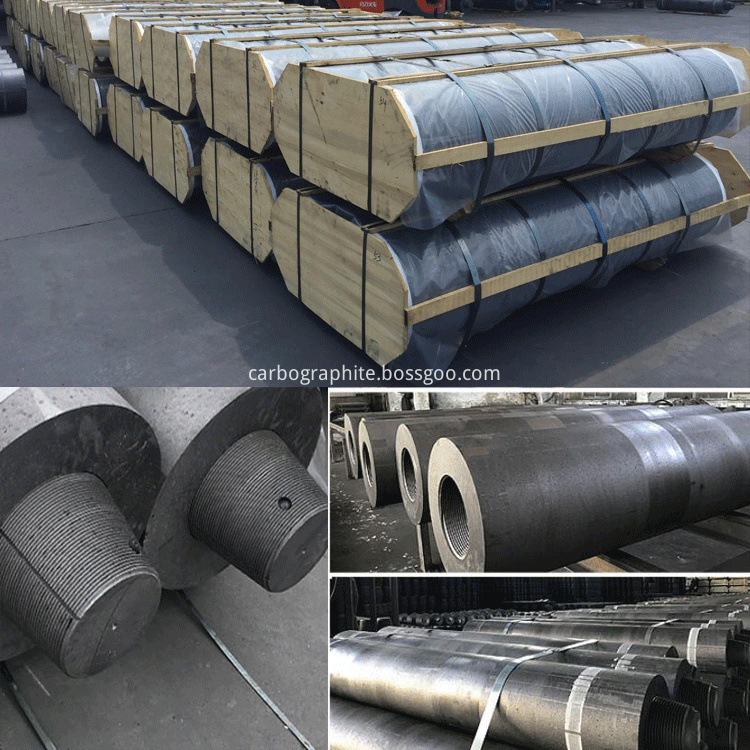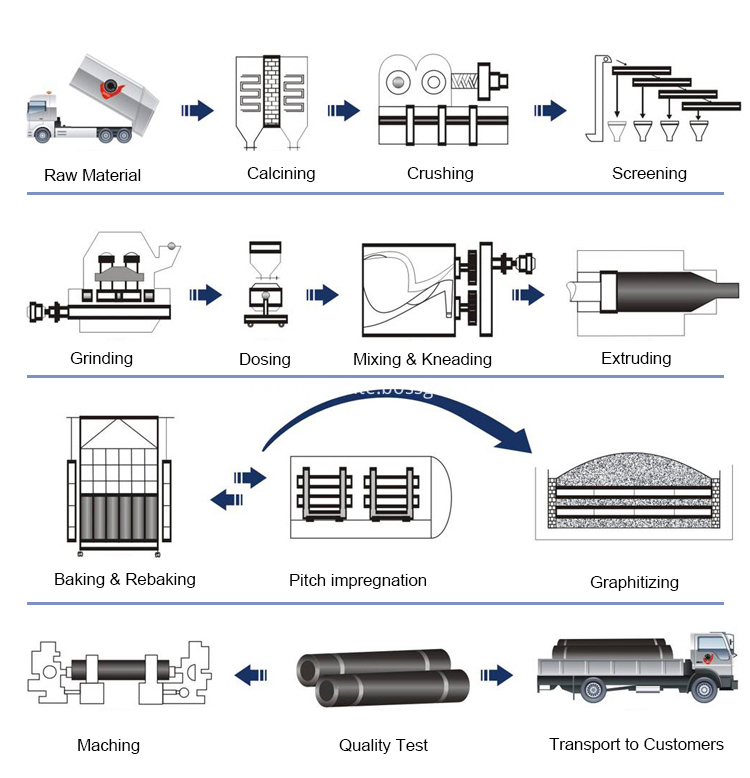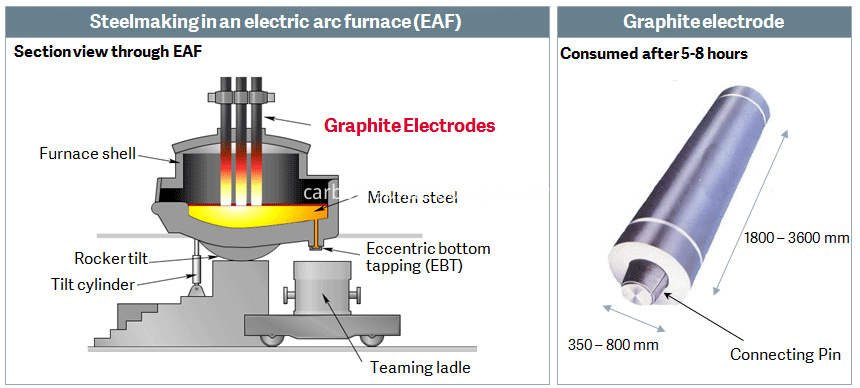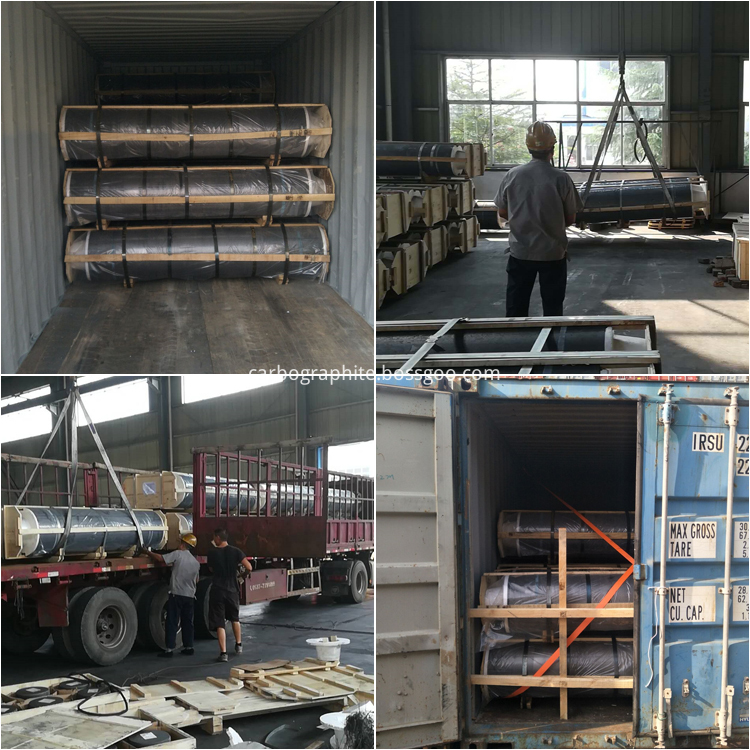HP400 Graphite electrodes are used for the smelting scrap steel in the electric arc furnace industry, so called “mini-mills”. They are also used in the refining of steel as well as in the non ferrous industries, where smelting processes are in use.
HP400 Graphite Electrode Rod for arc furnaces steelmaking
Synthetic Carbon Graphite Electrode are widely used in electric arc furnace (EAF) and ladle furnace (LF) for steel making production, ferroalloy production, silicon metal production and smelting processes. In addition to high temperature which can reach up to 3000℃ , these Electrodes of Graphite UHP700 for scrap are featured with excellent mechanical strength, thermal expansion, thermal shock resistance and machinability.
Technical Support
In CarboGraphite Company, beyond the standard procedure of selling graphite electrodes, we have a group of experts focusing on delivering an entire service since receiving customer orders. All of our technician are trained engineers who have been working in furnaces or graphite electrodes manufacturers for years. We are familiar with all EAF, Ladle, and Foundry applications. CarboGraphite guarantees all graphite electrodes are up to the industry standard and will be exactly meet customers expections.

Graphite Electrodes Grades:
• Ultra-high power (UHP)
• High power (HP)
• Regular power (RP)
Why Choose CarboGraphite Electrodes?
• Annual output: 50,000 metric tons, mass stock
• Strict quality control system, ISO9001 certified
• High purity needle coke
• Short lead time and on-time delivery guaranteed
• Your one-stop supplier, both stable product quality and rich experiences of after-sales service.
Details of Furnace Graphite Electrodes:

Graphite Electrode For Arc Furnaces Specifications:
|
Properties |
HP |
RP |
||||
|
Φ300-φ500 |
Φ550-φ800 |
Φ300-φ800 |
Φ300-φ800 |
|||
|
Resistivity (uΩm max) |
Electrode |
4.8-5.8 |
4.6-5.8 |
5.8-6.6 |
7.0-10.0 |
|
|
Nipple |
3.5-4.0 |
3.5-4.0 |
3.5-4.0 |
4.0-4.5 |
||
|
Modulus of rupture (Mpa) |
Electrode |
10.0-14.0 |
10.0-14.0 |
10.0-13.0 |
8.0-10.0 |
|
|
Nipple |
20.0-24.0 |
22.0-26.0 |
20.0-23.0 |
19.0-22.0 |
||
|
Young's modulus(Gpa) |
Electrode |
9.0-13.0 |
10.0-14.0 |
8.0-12.0 |
7.0-9.3 |
|
|
Nipple |
15.0-18.0 |
16.0-19.0 |
14.0-16.0 |
12.0-14.0 |
||
|
Bulk Density (g/cm³)min |
Electrode |
1.68-1.74 |
1.70-1.74 |
1.64-1.68 |
1.53-1.56 |
|
|
Nipple |
1.78-1.82 |
1.80-1.84 |
1.75-1.80 |
1.70-1.74 |
||
|
CTE (100-600℃)max |
Electrode |
1.1-1.4 |
1.1-1.4 |
1.6-1.9 |
2.2-2.6 |
|
|
Nipple |
0.9-1.2 |
0.9-1.2 |
1.1-1.4 |
2.0-2.5 |
||
|
Ash (%) |
|
0.3 |
0.5 |
|||
Carbon Graphite Electrode 4TPI Nipple Range and Nipple Size (4 buckles):
|
Nominal diameter(mm) |
Nipple type |
Nipple socket average diameter(mm) |
Nipple max diameter(mm) |
Nipple length(mm) |
Nipple socket depth(mm) |
Buckle length(mm) |
|
D4 |
D1 |
L1 |
L2 |
L3 |
||
|
800 |
432T4L |
428.64 |
431.80 |
635.00 |
323.50 |
319.50 |
|
750 |
406T4L |
403.24 |
406.40 |
609.60 |
310.80 |
306.80 |
|
750 |
406T4N |
403.24 |
406.40 |
584.20 |
298.10 |
294.10 |
|
700 |
374T4L |
371.49 |
374.65 |
558.80 |
285.40 |
281.10 |
|
700 |
374T4N |
371.49 |
374.65 |
457.20 |
234.60 |
230.60 |
|
650 |
355T4L |
352.44 |
355.60 |
558.80 |
285.40 |
281.40 |
|
650 |
355T4N |
352.44 |
355.60 |
457.20 |
234.60 |
230.60 |
|
600 |
317T4L |
314.34 |
317.50 |
457.20 |
234.60 |
230.60 |
|
600 |
317T4N |
314.34 |
317.50 |
355.60 |
183.80 |
179.80 |
|
550 |
298T4L |
295.29 |
298.45 |
457.20 |
234.60 |
230.60 |
|
550 |
298T4N |
295.29 |
298.45 |
355.60 |
183.80 |
179.80 |
|
500 |
269T4L |
266.72 |
269.88 |
457.20 |
234.60 |
230.60 |
|
500 |
269T4N |
266.72 |
269.88 |
355.60 |
183.80 |
179.80 |
|
450 |
241T4L |
238.14 |
241.30 |
355.60 |
183.80 |
179.80 |
|
450 |
241T4N |
238.14 |
241.30 |
304.80 |
158.40 |
154.40 |
|
400 |
222T4L |
219.09 |
222.25 |
355.60 |
183.80 |
179.80 |
|
400 |
222T4N |
219.09 |
222.25 |
304.80 |
158.40 |
154.40 |
|
350 |
203T4L |
200 04 |
203.20 |
304.80 |
158.40 |
154.40 |
|
350 |
203T4N |
200.04 |
203.20 |
254.00 |
133.00 |
129.00 |
|
300 |
177T4N |
174.64 |
177.80 |
215.90 |
114.00 |
110.00 |
Production Process of Graphite Electrode :

Work Diagram of Graphite Electrode for smelting scrap steel:

HP400 Graphite Electrode Rod for arc furnaces steelmaking
About CarboGraphite Company
CarboGraphite Industrial PTE.LTD, founded in 1992, is a comprehensive carbon electrodes and related products manufacturer in China, products covering Graphite Electrodes rod, electrode paste, Refractory, Flake Graphite, Petroleum Coke, and related products. Maintaining the high quality of both our products and services is vital to the long-term success of our company. We cooperate closely with distributors and terminal customers in the steel, steel refining and non ferrous smelting industries worldwide.
Annual Production Capacity
Graphite Electrodes: 50,000 MT
electrode paste: 200,000 MT
Calcined Coke: 250,000 MT
Refractories: 20000 MT
Long-term Stable Cooperation with Our Customers:

Shipping worldwide by Solid Wooden Pallet:

HP400 Graphite Electrode Rod for arc furnaces steelmaking
Welcome to Contact Us
 fangda carbon, kaifeng carbon, jilin carbon
fangda carbon, kaifeng carbon, jilin carbon


cindy@smeltingmateri
HP400 Graphite electrodes are used for the smelting scrap steel in the electric arc furnace industry, so called “mini-mills”. They are also used in the refining of steel as well as in the non ferrous industries, where smelting processes are in use.
cindy@smeltingmateri
HP300 Graphite electrodes are used for the recycling of steel in the electric arc furnace industry, so called “mini-mills”. They are also used in the refining of steel as well as in the non ferrous industries, where smelting processes are in use.
sean@smeltingmateria
Graphite electrodes are used for the recycling of steel in the electric arc furnace industry, so called “mini-mills”. They are also used in the refining of steel as well as in the non ferrous industries, where smelting processes are in use.